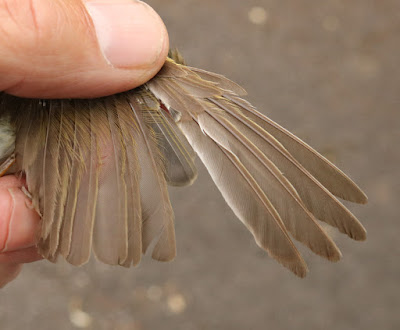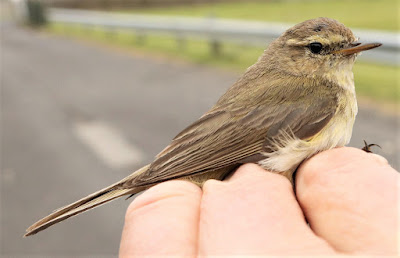Friday’s ringing session at Oakenclough began with a cracker of a bird, an immaculate, recently fledged Redstart with a fiery orange tail.
It’s a species that we rarely catch at Oakenclough, perhaps one or two each year in habitat that lacks the mature birch and oak woodland that Redstarts favour. Such woodland is fairly near and also a couple of miles away on the edge of Bowland from either of which our annual Redstarts may originate.
A juvenile Redstart has the blotchy looks and overall demeanour of a juvenile Robin. Without the red tail, a Redstart could impersonate a Robin. The two species share many habits, actions and chat-like behaviour but the Redstart is slightly slimmer and not quite as heavy.
We started with the firecracker bird but the session fizzled out with the catching of other site rarities that leave us unmoved, a humdrum Blue Tit and an uninteresting Great Tit.
It seems we are not alone with a lack of Willow Warblers that other ringers report during June and now July. Just two Willow Warblers caught - one adult and one juvenile when normally we should be into double figures for a July ringing session. The single adult male was well into the stage of replacing all of its flight feathers in readiness for autumn and the journey back to deepest Africa.
During the morning we’d heard a few Siskins overhead with their unmistakable high-pitched “ping” flight call and hoped we might catch one or two. The Siskin is another species that breeds close by but not on site and we expect to catch them on their in spring and autumn migrations rather than summer. The flight call of a Siskin is of course unique and one that once learnt is not forgotten and can be picked out during autumn visible migration watches. Click on the sound track below to hear the call of a Siskin.
But catch we did, a second summer male, the actual one shown below.
Siskin
Siskin
A recently fledged Goldcrest was without a crest of gold or any other colour which rather confirmed the fact that Goldcrests breed in the conifers just across the stone wall that borders the ringing site. These youngsters begin to develop colour on their crown feathers at their partial moult within a couple of weeks of leaving the nest.
The Chiffchaff was also a post juvenile wanderer from not too far away. The species does not breed within our ringing plot.
To recap, the morning of ones and twos and 10 birds caught - 2 Willow Warbler, 1 Treecreeper, 1 Redstart, 1 Chiffchaff, 1 Siskin, 1 Goldcrest,1 Blue Tit, 1 Wren,1 Great Tit.
Better luck next time?
Apologies for the loss of the header width. It seems that once again Blogger changed a setting that worked well for 10+ years. When I changed the header picture to a Yellow Wagtail, Blogger automatically shrunk the picture. I'm still working to fix this but if anyone knows the settings of old, please let me know.
For the weekend I am linking to Eileen's Blogspot and Anni in Texas.




































8 comments:
I've never heard of a redstart but he is beautiful. Love the yellow siskin too
You always have such interesting posts!
Thanks for visiting us at https://image-in-ing.blogspot.com/2021/07/a-favorite-place-to-visit.html
Phil - sorry your promising start fizzled. There's always tomorrow.
We have loads of siskins and their zing sound is very obvious once you know it.
I've never heard of a redstart either. Like Carol says, it certainly is beautiful!
Love the photos, Phil.
Buen trabajo Phil!!! Saludos desde el norte de España.
Phil - to answer your questions on my blog - I was aware of Pygmy Owls in the area because I have seen one perched at the top of a tree, and we can hear their calls at night. The black bear is the more mild-mannered bruin; the grizzly is the one you have to watch out for!
Birds are the one to save the environment...but technology rapid growth ,extinct these kind of bird...these kind of posts makes awareness to save the birds
petsgain
Lovely photographs Phil.
The Redstart really does have a nice red tail, well perhaps it's more orangey red!
Hope your week has gone well.
All the best Jan
Post a Comment